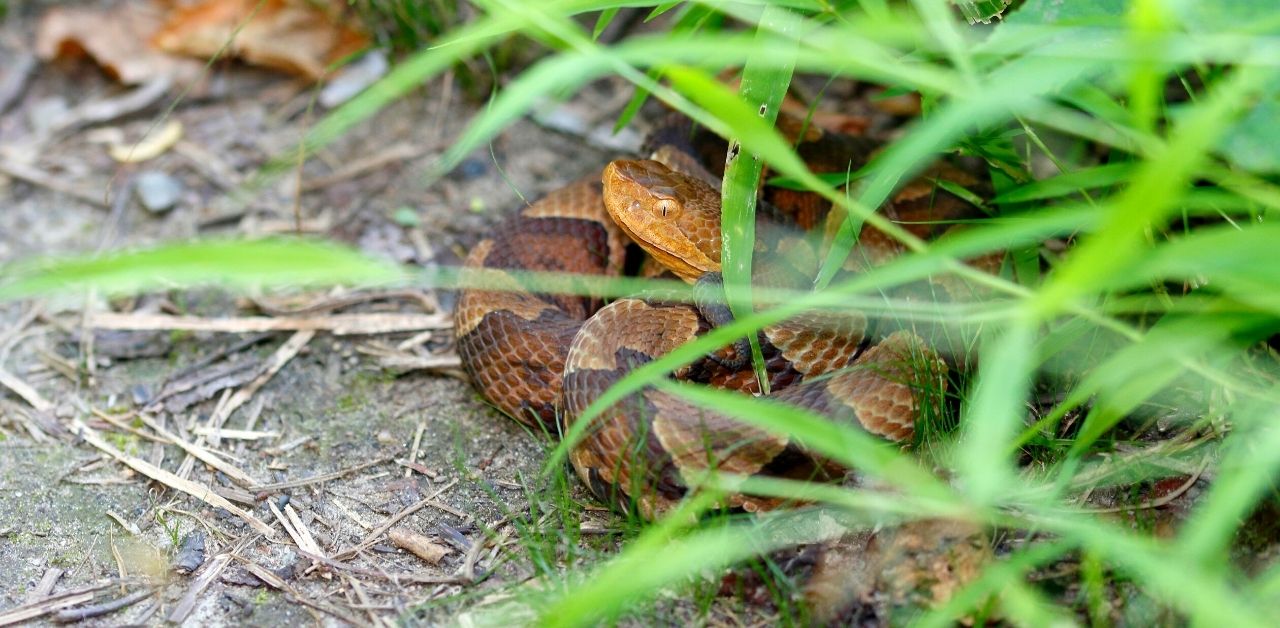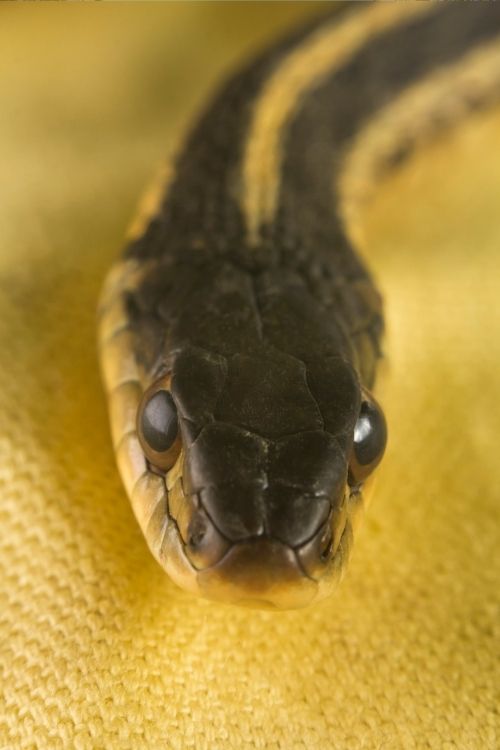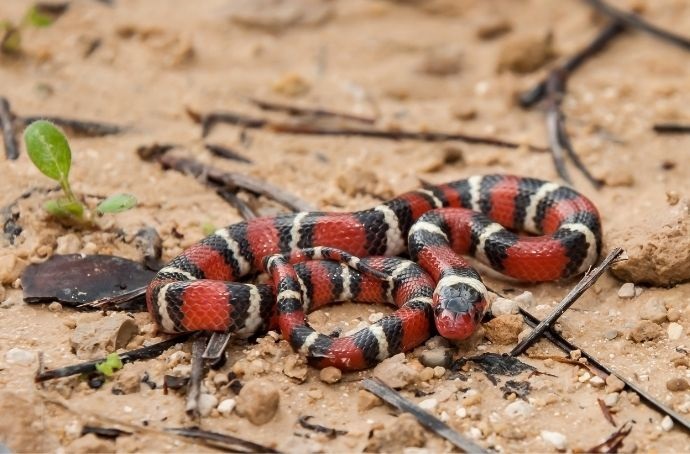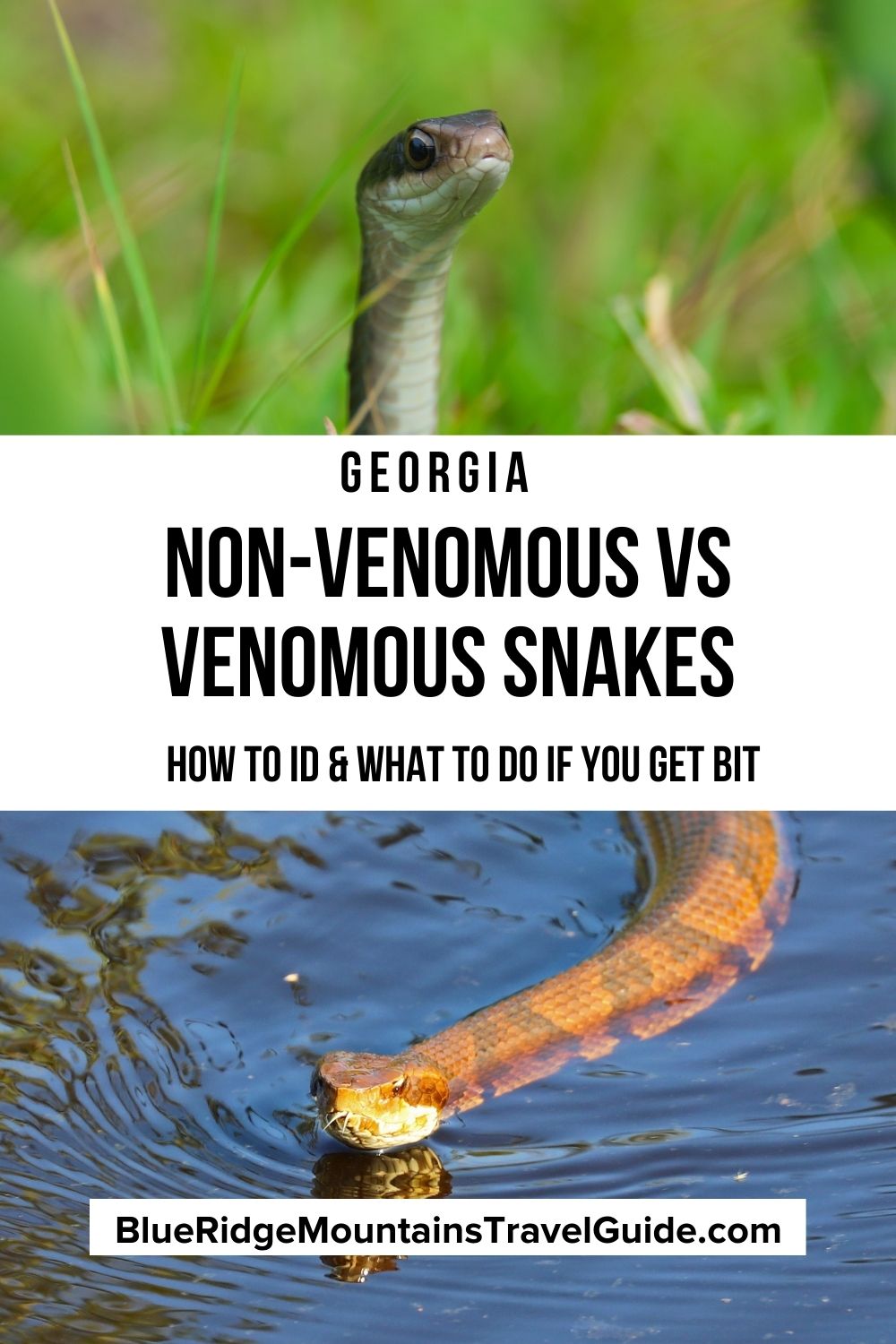“Why’d it have to be snakes?!?!”
This memorable line– spoken by Indiana Jones in the 1984 classic Raiders of the Lost Ark– reveals a bizarre truth. Even a badass, jungle-roaming, whip-cracking Nazi hunter can have an irrational fear of slithering reptiles.
Just hearing the word “snake” can evoke feelings of fear in otherwise intrepid adventurers. Which is ironic when you consider the fact that snakes are much more afraid of us than we are of them, and will rarely attack unless provoked.
The majority of snake bites happen from people accidentally stepping on snakes, handling snakes, or trying to kill them. So if you do see a snake on a hiking trail, just leave them be and it’s extremely unlikely you’ll get bitten.
In truth, the number of snake bites that occur annually is relatively low and the chance of being fatally bitten is minuscule.
According to CDC statistics, an estimated 7,000 to 8,000 people are bitten by venomous snakes in the U.S. each year, and only about 5 of those bites are fatal (usually due to preexisting conditions). To put that number in perspective, lightning kills an average of 49 people each year, while over 30,000 people are killed in car crashes each year.
But while your risk of getting a snake bite while exploring nature is extremely low, it’s important to arm yourself with knowledge before venturing into their territory. Knowledge leads to understanding and respect for the vital role these beautiful creatures play in the ecosystem of North Georgia.
Read on to learn all about the different types of snakes in Georgia, how to identify non-venomous vs venomous snakes, and what to do in the unlikely case that you or your dogs get bit while out on the trails.
READ MORE: 101+ Things to Do in North Georgia
Non-Venomous vs Venomous Snakes: How to ID
The Georgia Poison Center recorded 416 snake bites in 2018, with half of them coming from non-venomous snakes.
While all snake bites and sightings should be taken seriously, it’s important to be able to tell non-venomous vs venomous snakes apart. First, to help minimize your fear, and second, because it is illegal to kill non-venomous snakes in Georgia.
There are 46 different species of snakes in Georgia, and only six of those are venomous. So it’s much more likely that you will come across a non-venomous snake than a venomous one.
Venomous snakes tend to have:
- a more stocky build
- distinct triangular-shaped heads (non-venomous snakes tend to have more rounded heads)
- elliptical pupils, almost like those of a cat (non-venomous snakes have rounded pupils)
- pits or holes on the head (rattlesnakes, copperheads, cottonmouths, etc. will have two on their snouts)
Another way of knowing if a snake is venomous is if you hear a rattle, which serves as a warning that there is a rattlesnake nearby.
Note that some non-venomous snakes can mimic the sound of a rattle by rustling their tail in leaves. But it’s better to exercise caution and back away slowly and carefully if you hear a rattle nearby.
READ MORE: The 15 Best North Georgia Mountains for Hiking
Commonly Confused Venomous and Non-Venomous Snakes
One of the six venomous snakes in Georgia, the Eastern Coral Snake, is commonly mistaken for the non-venomous Scarlet Kingsnake.
An easy way to tell the difference is by looking at their color pattern and remembering the saying, “red touch yellow, deadly fellow; red touch black, venom lack.” So if the red and yellow rings are touching, it’s venomous!
Another frequently misidentified (and widely feared) venomous snake is the Cottonmouth, which is more commonly known as the Water Moccasin.
Many people automatically assume when they see a snake in the water that it must be a Water Moccasin. But there are actually five other species of non-venomous water snakes in Georgia, and they are MUCH more commonly sighted!
The first step to identifying if the snake is a Water Moccasin is considering where you are geographically. Water Moccasins do not naturally occur in the northern half of the state and are rarely (if ever) found in the North Georgia mountains.
They also tend to shy away from open lakes and reservoirs. They instead prefer to inhabit slow-moving streams, backwaters, and swamps.
Cottonmouths can also be identified by their swimming behavior and body. Their body, though thick and stocky, appears to be incredibly buoyant and their head will be elevated above the water.
Non-venomous water snakes are much slimmer, yet they tend to swim in, rather than on top of the water.
READ MORE: The 20 Best North Georgia Waterfalls (& How to Get to Them)
Venomous Snakes in Georgia

Copperhead
agkistrodon contortix
Copperhead snakes get their name from their copper-red heads. Their head lacks the hourglass-shaped crossbands (which some people refer to as Hershey’s Kisses) that are found on the rest of their body.
Young Copperheads usually sport a bright yellow tail tip that is used to lure small prey, such as frogs and lizards. When fully mature, they lose the yellow tail tip and grow to around 2 to 3 feet in length.
These snakes can be found in a wide variety of habitats, ranging from dry, rocky areas to forests and wetlands.
Copperheads in Georgia can also be found in suburban neighborhoods where there are patches of forest. This explains why they’re responsible for the majority of snakebites in the Southeast each year.
Their range covers most of the state (excluding south-central Georgia), and their diet consists mostly of mice, but also small birds, lizards, rabbits, frogs, toads, and insects.
READ MORE: The 20 Best Hiking Trails in North Georgia Bucket List

Cottonmouth / Water Moccasin
Agkistrodon piscivorus
Cottonmouths get their name from the white coloring inside their mouth, which can be seen during displays of self-defense.
They’re muscular snakes with thick bodies that vary in color from dark brown to olive, with a black band that extends from their eyes towards their neck. This can help you distinguish it from other Georgia water snakes, which lack the band.
Fully grown Water Moccasins can reach 3 to 4 feet in length and feed on fish, small mammals, birds, amphibians, turtles, crayfish, insects, and smaller snakes.
Cottonmouths can be found throughout the southeastern United States and are semi-aquatic, meaning they can live both on land and in water.
Most all freshwater habitats can be home to Cottonmouths, but they seem to prefer lush wetlands, cypress swamps, and river floodplains. In Georgia, they are most commonly spotted in the southern Coastal Plain area.
READ MORE: The 10 Best Waterfalls Near Blue Ridge GA
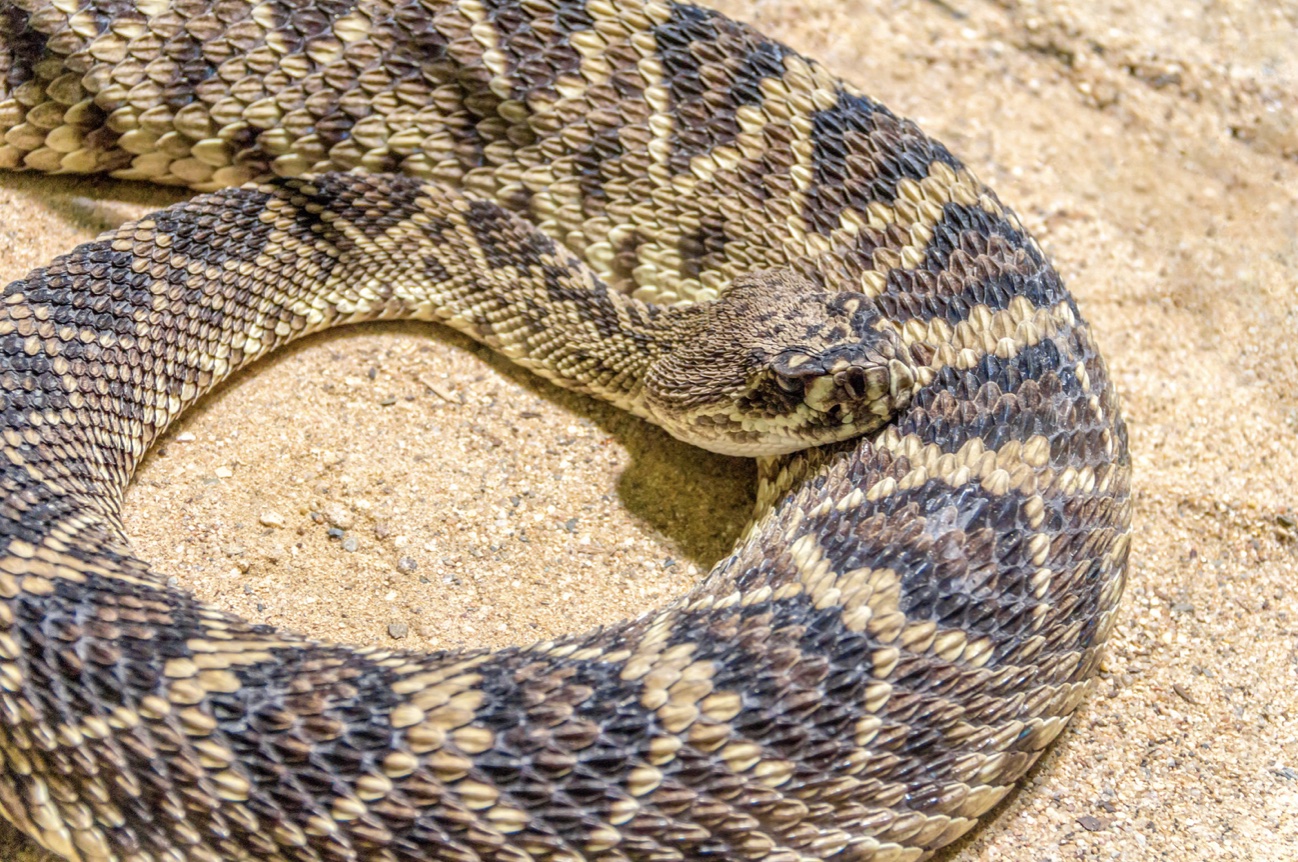
Eastern Diamondback Rattlesnake
Crotalus adamanteus
Eastern Diamondback Rattlesnakes are the largest venomous snake in North America, and can grow up to 8 feet in length. More commonly they will measure around 3 to 5 feet.
Their body is a brown, tan, or yellowish color and is adorned with their iconic diamond pattern, which is a deep brown and surrounded by lighter scales.
The tip of their tail features a rattle made of loosely attached hollow segments that the snake will frantically shake as a warning when threatened.
Eastern Diamondbacks live in dry, sandy areas, pine flatwoods, and coastal dune habitats from North Carolina to Florida and west to Louisiana. They typically avoid wet areas, but will sometimes be spotted along the edges of swamps.
Their diet consists of rats, mice, squirrels, and birds which they detect by heat (infrared radiation) and scent. They are incredibly accurate predators, and can strike a target at a distance of up to two-thirds their body length.
READ MORE:The Best Places to Go White Water Rafting in GA
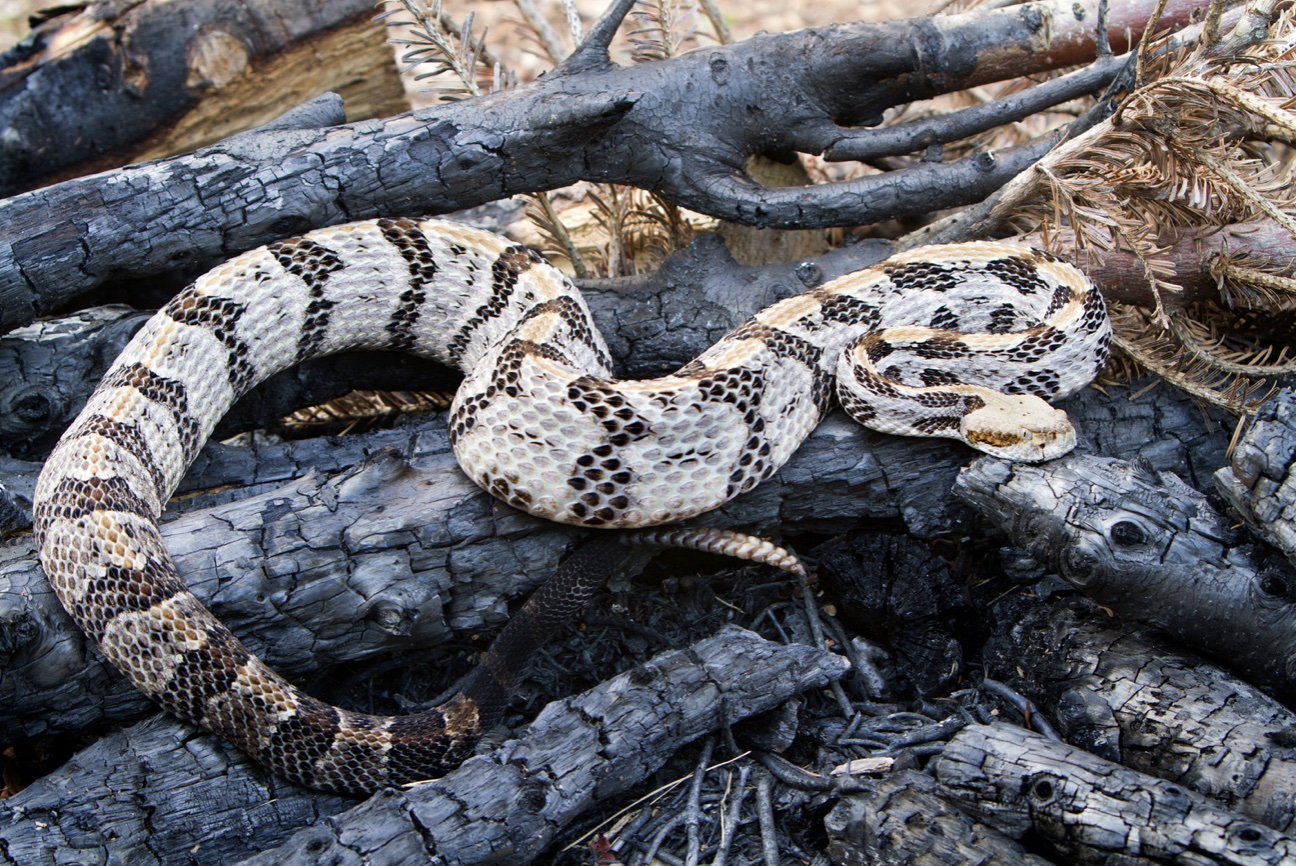
Timber Rattlesnake / Canebrake Rattlesnake
Crotalus horridus
Ranging anywhere from 2.5 to 5 feet long, the Timber Rattlesnake (a.k.a. Canebrake Rattlesnake) is a grayish color with a series of black, chevron-like crossbands and a long orange or brown stripe running along the length of their body.
This species of venomous pit viper can be found all across the eastern US (except Florida) in lowland cane thickets, hardwood and pine forests, mountainous areas, high areas around swamps, river floodplains, and rural habitats near farms.
During spring and fall, they are diurnal (meaning they’re active during the day). But in the heat of summer, they become nocturnal, meaning they’re most active at night.
Their prey consists of small rabbits, moles, and other rodents as well as lizards, snakes, amphibians, and insects.
Like many other pit vipers, they are ovoviviparous, meaning the mother carries eggs inside of her body until they are ready to “hatch” and then gives birth to live young.
READ MORE: Fall in the Mountains of North Georgia (Where to See the Best Fall Colors)
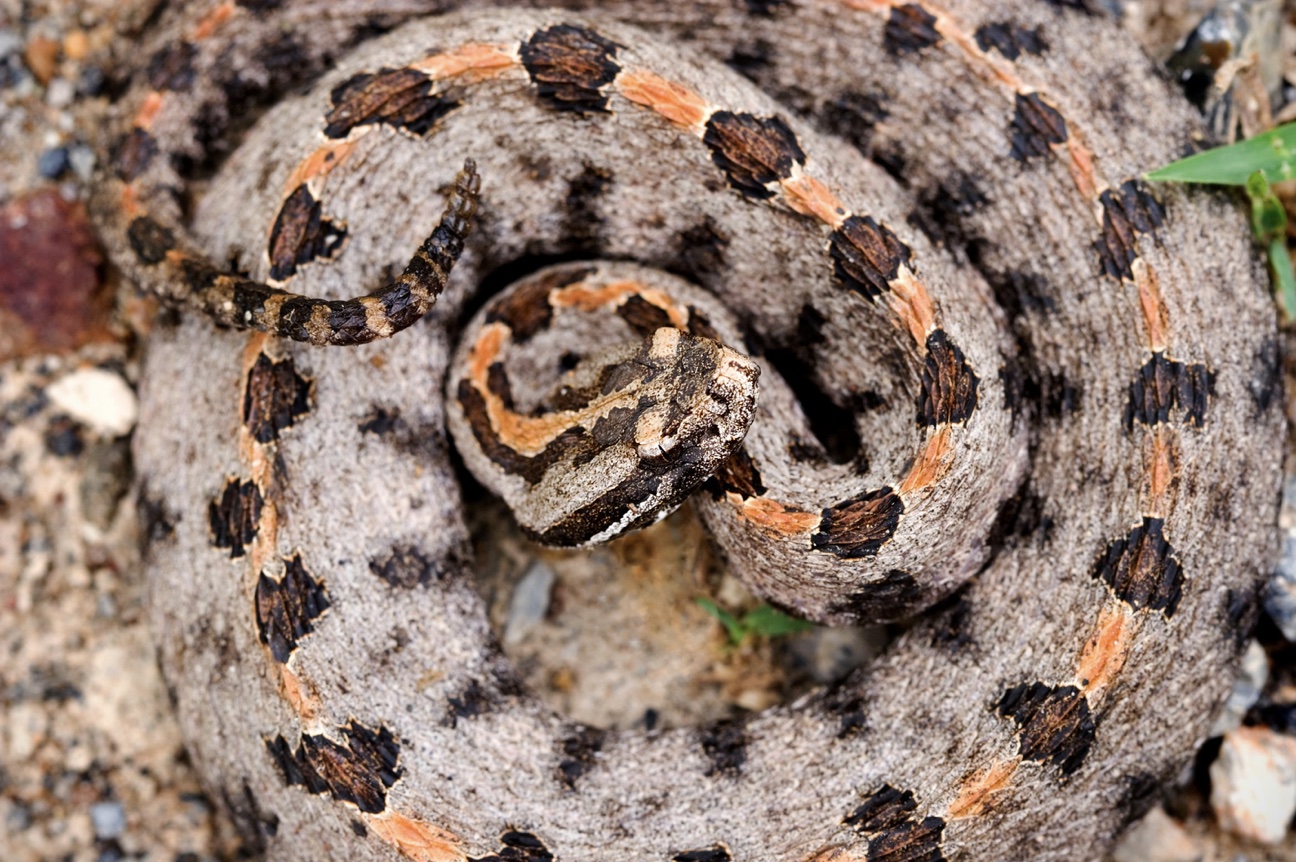
Pigmy Rattlesnake
Sistrurus miliarius
Ranging across the southeastern US, in Georgia Pigmy Rattlesnakes are most commonly in the northeast, northwest, and central areas. They can be found in wet and dry habitats, including creeks, mixed forests, swamps, and sandhills.
Their coloring may be grey, tan, or even a light lavender, with an orange or reddish-brown dorsal stripe.
Although stocky, they are relatively small and usually do not exceed 2 feet, including their tiny rattle. In fact, their rattle is so tiny it is rarely even heard.
Pigmy Rattlesnakes spend most of their time hidden among the leaves. They’ll hide there, waiting to ambush their prey, which includes lizards, frogs, and small mammals.
Young Pigmys primarily prey on insects and use “caudal luring,” a method where the snake moves its tail to mimic an insect.
READ MORE: Things to Do at James H Floyd State Park in Summerville GA
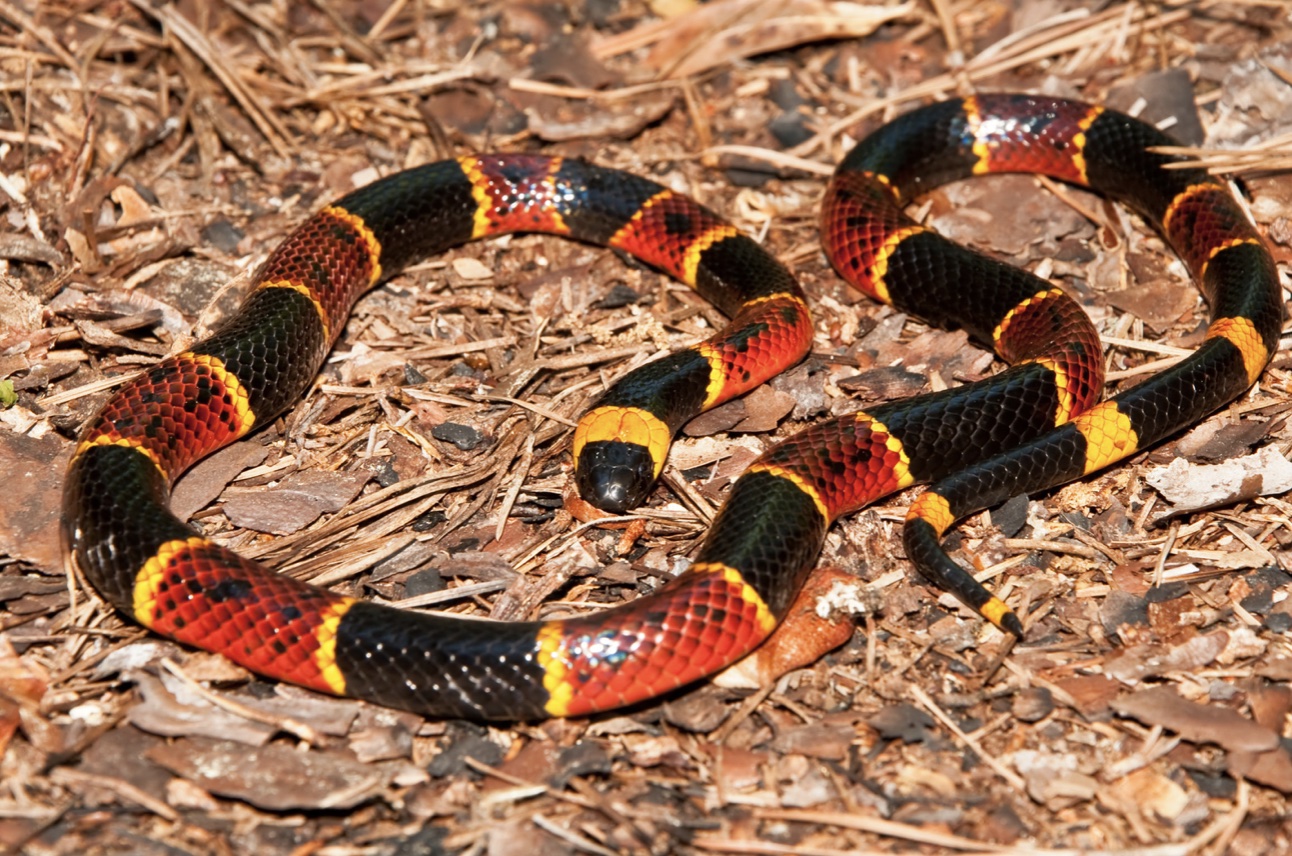
Eastern Coral Snake
Micrurus fulvius
Eastern Coral Snakes belong to the family Elapidae, making them relatives of the Mamba, Cobra, and Sea Snake.
They have slender bodies that grow to be around 1.5 to 2.5 feet long, with a more blunt snout compared to most snakes.
The black, red, and narrow yellow rings that encircle their body are what make Eastern Coral Snakes so recognizable (although they are commonly confused with the non-venomous Scarlet Kingsnake).
Remember: Red touch yellow, deadly fellow; red touch black, venom lack!
You can find Eastern Coral Snakes in the sandy, wooded, and marshy areas of the southeastern United States, where they spend most of their lives burrowed underground.
Their diet consists of frogs, lizards, and smaller snakes, even including other coral snakes!
READ MORE: The 15 Best Things to Do in Blue Ridge, GA
Non-Venomous Snakes in Georgia
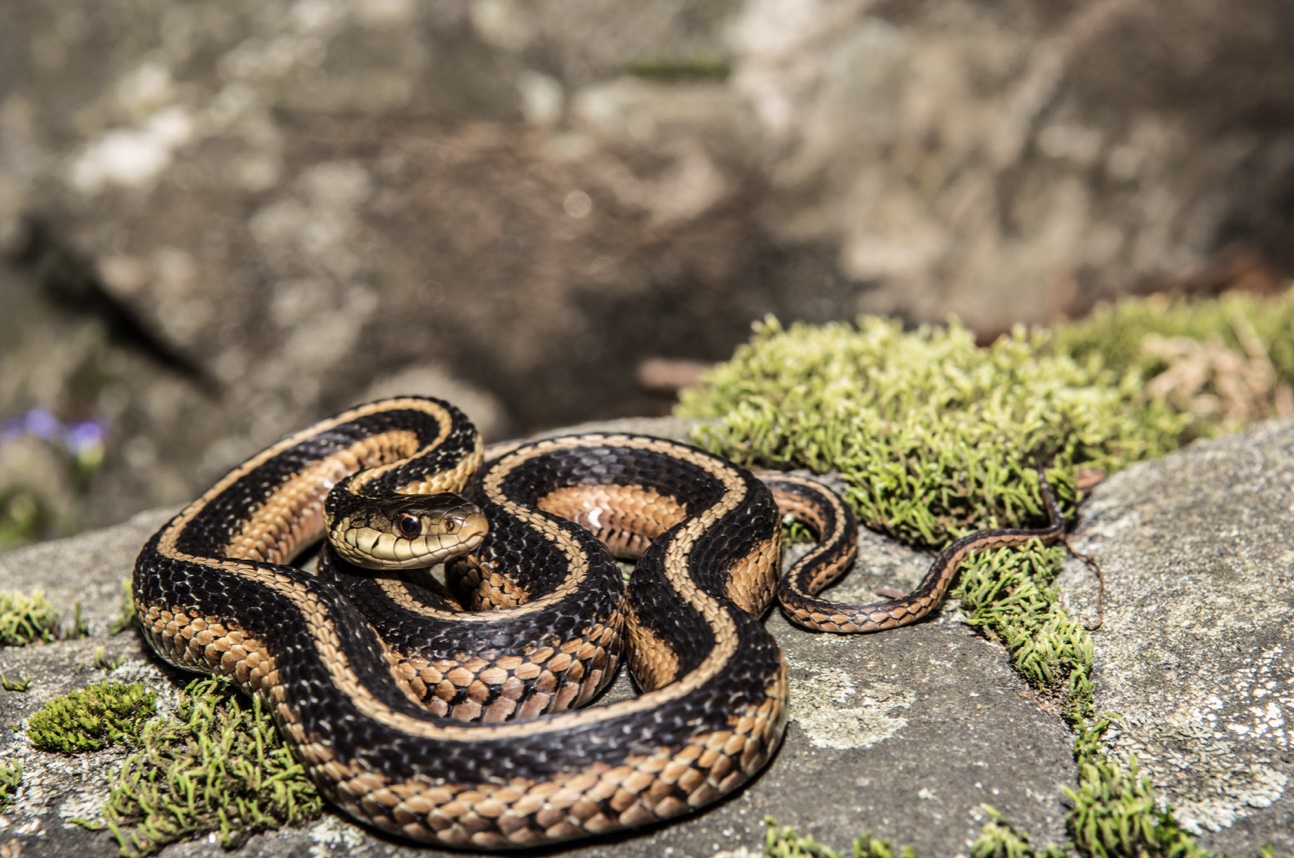
Eastern Garter Snake
Thamnophis sirtalis
Common throughout the eastern United States, Garter Snakes are actually one of the most wide-ranging species of snakes in North America.
They call a variety of habitats home, including woodlands, marshes, meadows, and hillsides, and are often found close to the edges of lakes, streams, and ponds.
They are also one of the most commonly encountered snakes in suburban areas, where there is cover such as rocks or vegetation.
These snakes tend to have varied coloration, with some exhibiting a checkered pattern. But they are easily identified by a prominent yellow stripe running down the middle of a darker body.
They range from 1.5 to just over 2 feet long and feed on slugs, frogs, toads, worms, salamanders, fish, and tadpoles.
READ MORE: The 15 Best Lakes in the North Georgia Mountains
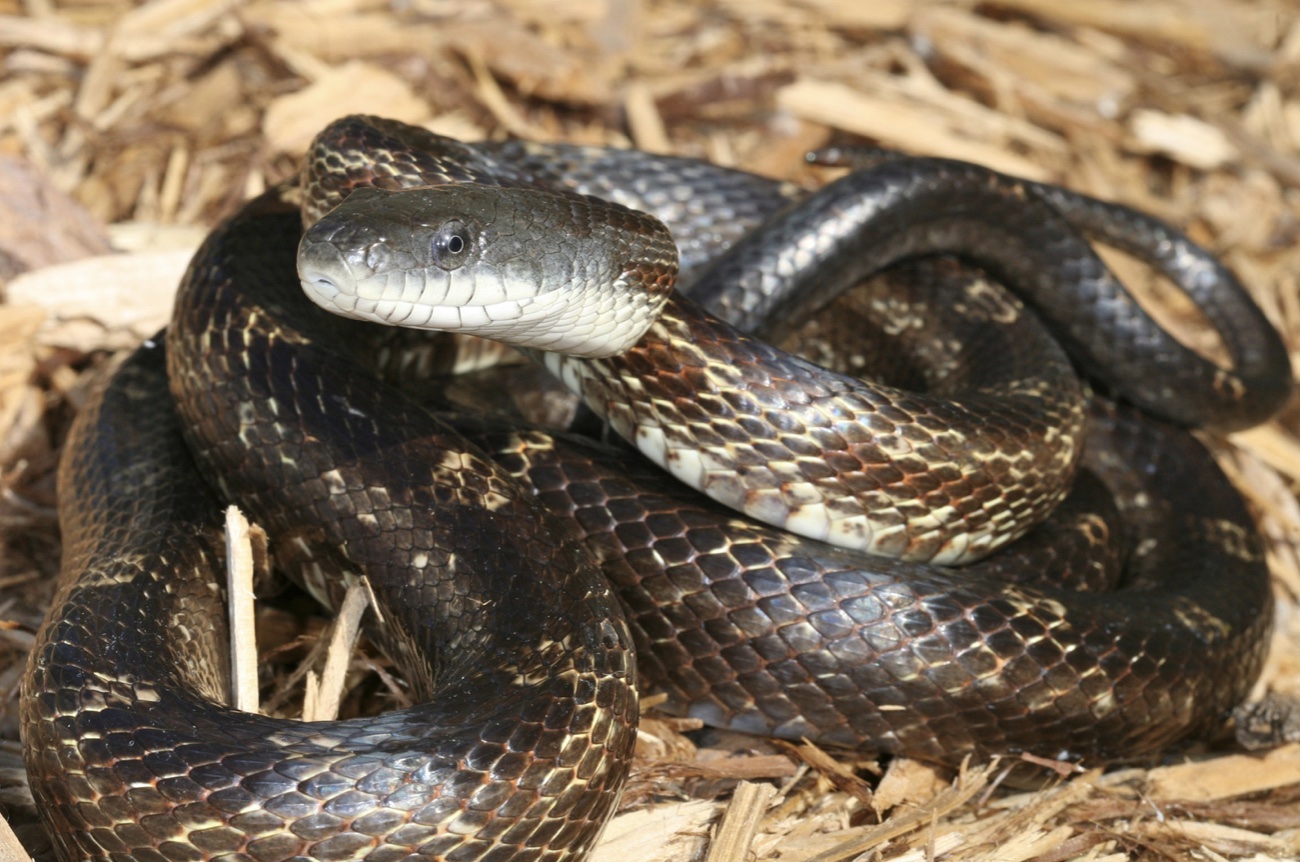
Rat Snake
Pantherophis obsoleta
Rat Snakes encompass a wide range, including every southeastern state and most eastern and midwestern states (going as far north as southern Michigan). In Georgia, Rat Snakes are particularly prominent in the Piedmont region.
Their habitats vary from hardwood forest and rocky timbered hills to river floodplains and swamps. But they are also commonly found in abandoned buildings and even suburban areas.
Depending on what region they’re found in, their appearance fluctuates from black to a yellowish or grey color. But they will all be around 3 to 5 feet in length.
As their name would seem to indicate, Rat Snakes eat mice, rats, squirrels, and birds. To some people’s amazement, they are incredible climbers and can easily scale tree trunks and brick walls.
READ MORE: The Top 10 Treehouse Rentals in the Georgia Mountains
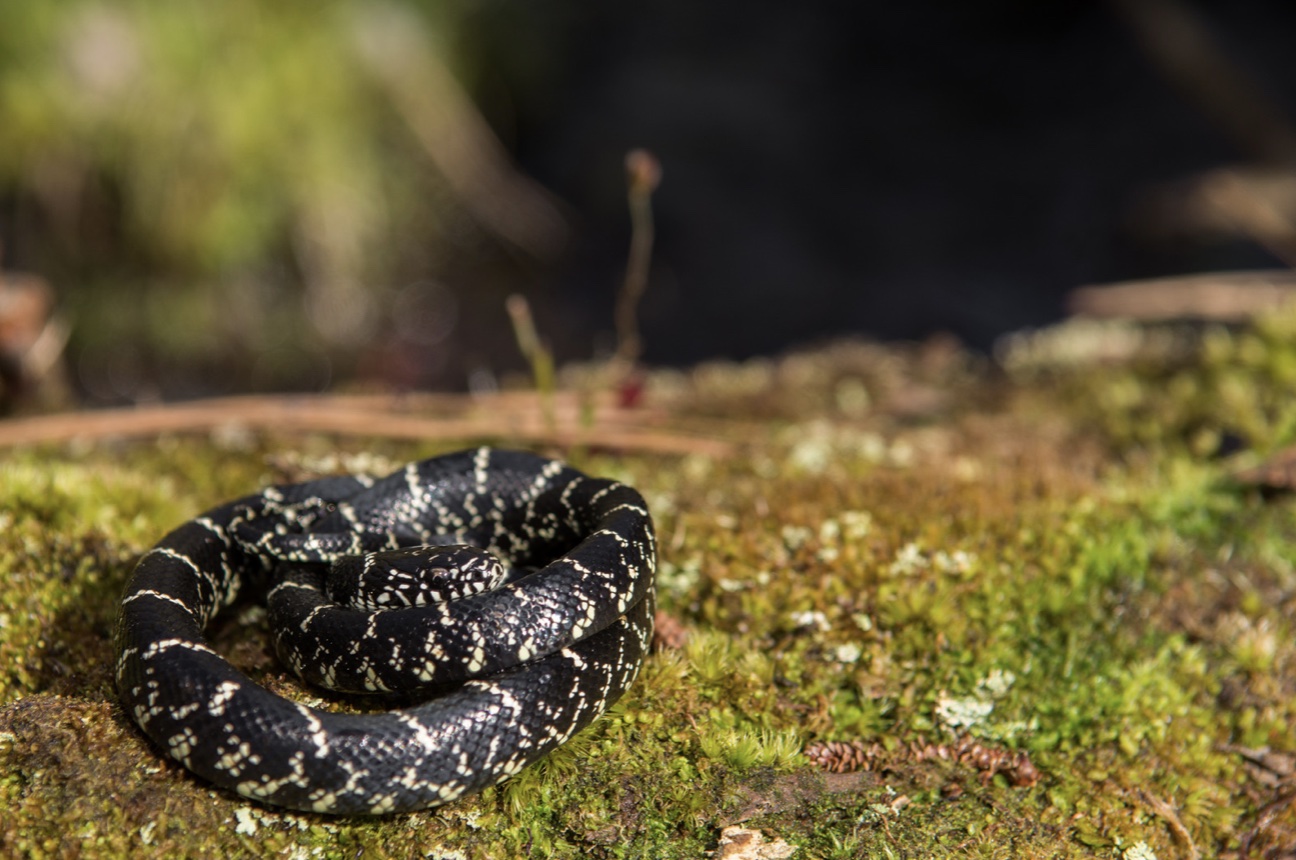
Eastern Kingsnake
Lampropeltis getula
The Eastern Kingsnake can be found across the eastern United States and in all areas of Georgia, primarily in hardwood and pine forest, swamps, bottomlands, and tidal wetlands.
They can also be seen in suburban areas and farmlands, where they’re often found hiding under boards or scrap metal.
Growing to around 3 to 4 feet when fully mature, they have shiny black scales that are marked with prominent white or yellow chain-link bands.
Those that live in the Coastal Plains tend to have wider bands, while those that live in the mountains have thinner bands and can be almost completely black.
Eastern Kingsnakes are strong constrictors that prey on lizards, rodents, birds, turtle eggs, and other snakes.
Eastern Kingsnakes are totally resistant to the venom of pit vipers, so they have no fear of chowing down on Copperheads, Cottonmouths, and Rattlesnakes! If venomous snakes scare you, these beauties are great to have around.
READ MORE: Apple Picking in Georgia: The 10 Best North GA Apple Orchards to Visit
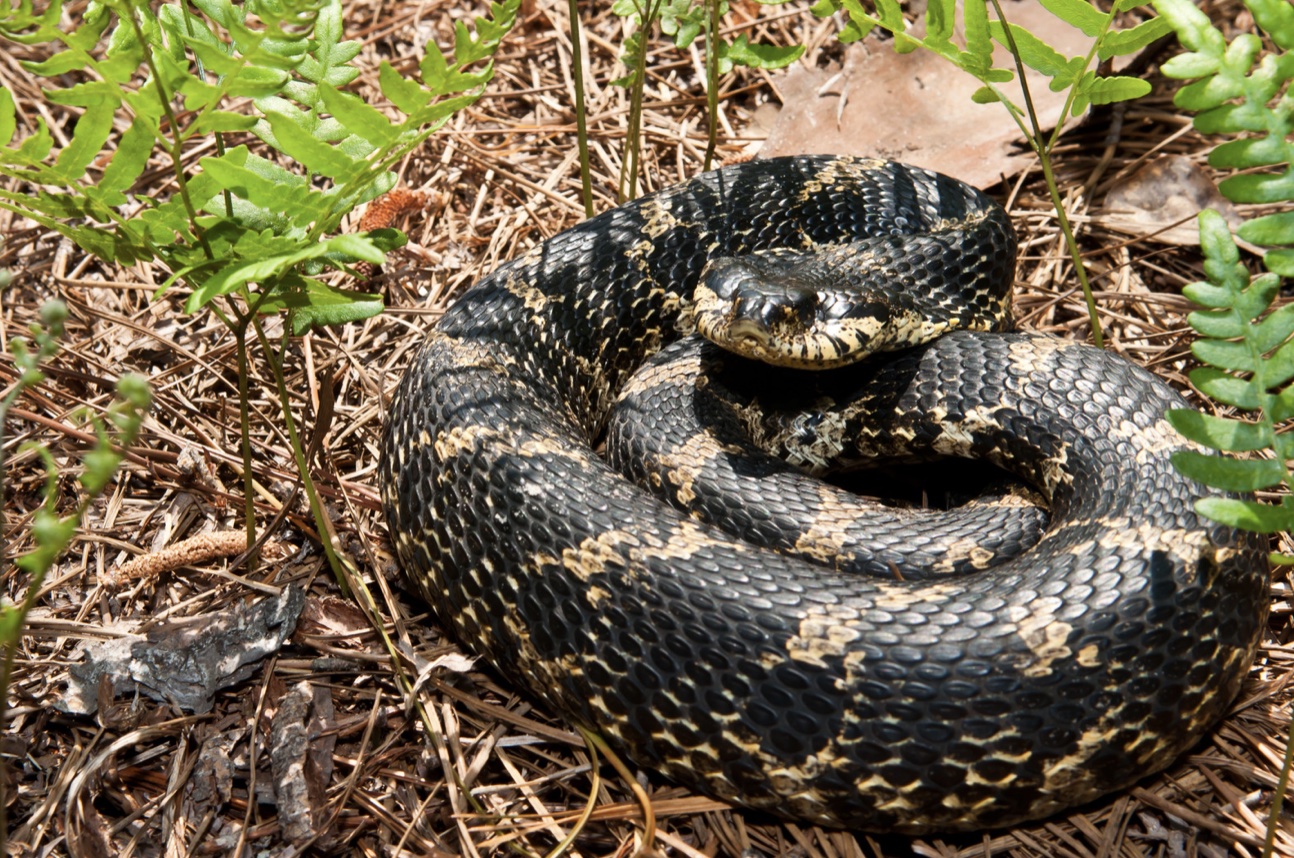
Eastern Hognose Snake
Heterodon platirhinos
Eastern Hognose Snakes can be found in the eastern half of the United States, all the way from southern Florida and Georgia up to some parts of southern Canada.
They’re variable in color, with a background of either brown, black, gray, or yellowish-green. They have somewhat defined spots on their back that can resemble eyes.
While it can be hard to identify them because of their varying color, it is their upturned snouts and rather dramatic response when threatened that usually distinguishes them.
If confronted, they’ll suck in air, puff out their head and neck (much like a cobra), hiss, and pretend to strike. If that doesn’t work they’ll usually roll on their back, open their mouth, and play dead! It’s quite the dramatic display.
Their prey consists of salamanders, birds, small mammals, and invertebrates, but their favorite snack by far is toads.
READ MORE: The 20 Best Pumpkin Patches in North Georgia to Visit

Brown Snake
Storeria dekayi
Also called DeKay’s Snake, the Brown Snake lives throughout the eastern US (except on high mountain elevations). In the deep south of Georgia, you’re actually more likely to see their close relative, the Florida Brown Snake.
But in the Piedmont and parts of the Coastal Plain, you can find the Brown Snake in a variety of woodland habitats, cypress swamp edges, and wetlands.
They’ve also earned the reputation of being a “city snake.” They’re one of the more popular snakes in urban habitats, where they are often mistaken for Copperhead Snakes.
As their name would suggest, they’re brown with two rows of dark spots. They are a tiny species of snake that hardly ever reaches over a foot long.
This is also how you can distinguish them from venomous snakes: When Copperheads are that small, they will have bright yellow tail tips, whereas Brown Snakes do not.
READ MORE: The 15 Best Things to Do in Clayton, GA (the Gem of Northeast Georgia)

Eastern Ribbon Snakes
Thamnophis sauritus
These slender snakes range from just over one to two feet long and have three light yellow stripes running along their back that contrast their dark background color.
The pattern is very similar to their cousins, the Eastern Garter Snake. However, Ribbon Snakes tend to be more slender and do not have dark markings on their labial scales.
You can find the Eastern Ribbon Snake throughout the eastern US, aside from the majority of the Appalachian Mountains. In Georgia, they primarily live in the Piedmont region and Coastal Plain.
These gorgeous snakes are semiaquatic and usually found at the edges of bogs, salt marshes, and lakes, where they feed on small fish and amphibians.
READ MORE: The Top 20 Blue Ridge Mountain Towns in GA & NC
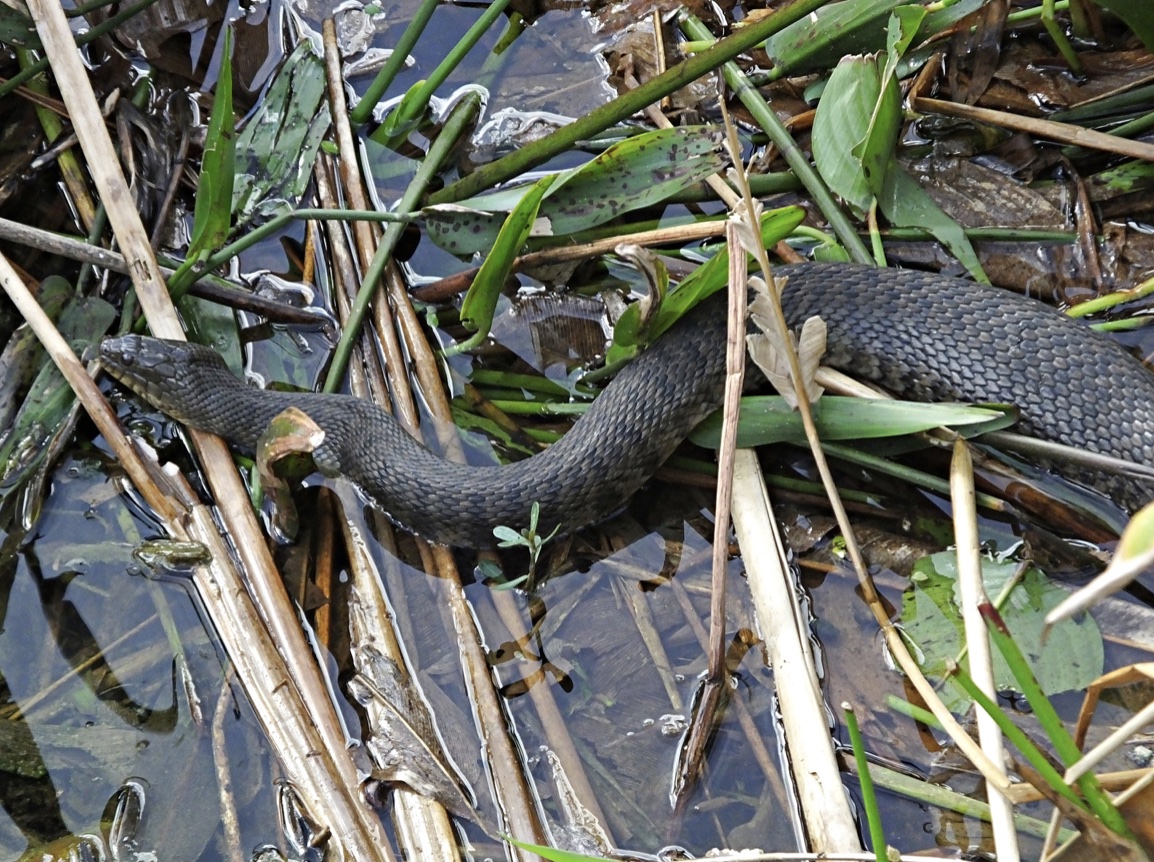
Green Water Snake
Nerodia floridana
Green Water Snakes are one of the largest watersnakes in North America, growing to around 4.5 feet long. They have stout bodies that are a greenish-brownish color, with no prominent markings other than dark speckling.
Female Green Water Snakes tend to be larger than males, but have shorter tails and typically give birth to around 20 to 30 live young between June and September.
They are endemic to the Southeast and can be found in southern Georgia, throughout Florida, and in southern South Carolina.
They prefer to live in still waters, like swamps and marshes. But they can also be found in ponds, lakes, ditches, and slow rivers, where they feed on amphibians and fish.
READ MORE: The 10 Best Wineries in the North Georgia Mountains
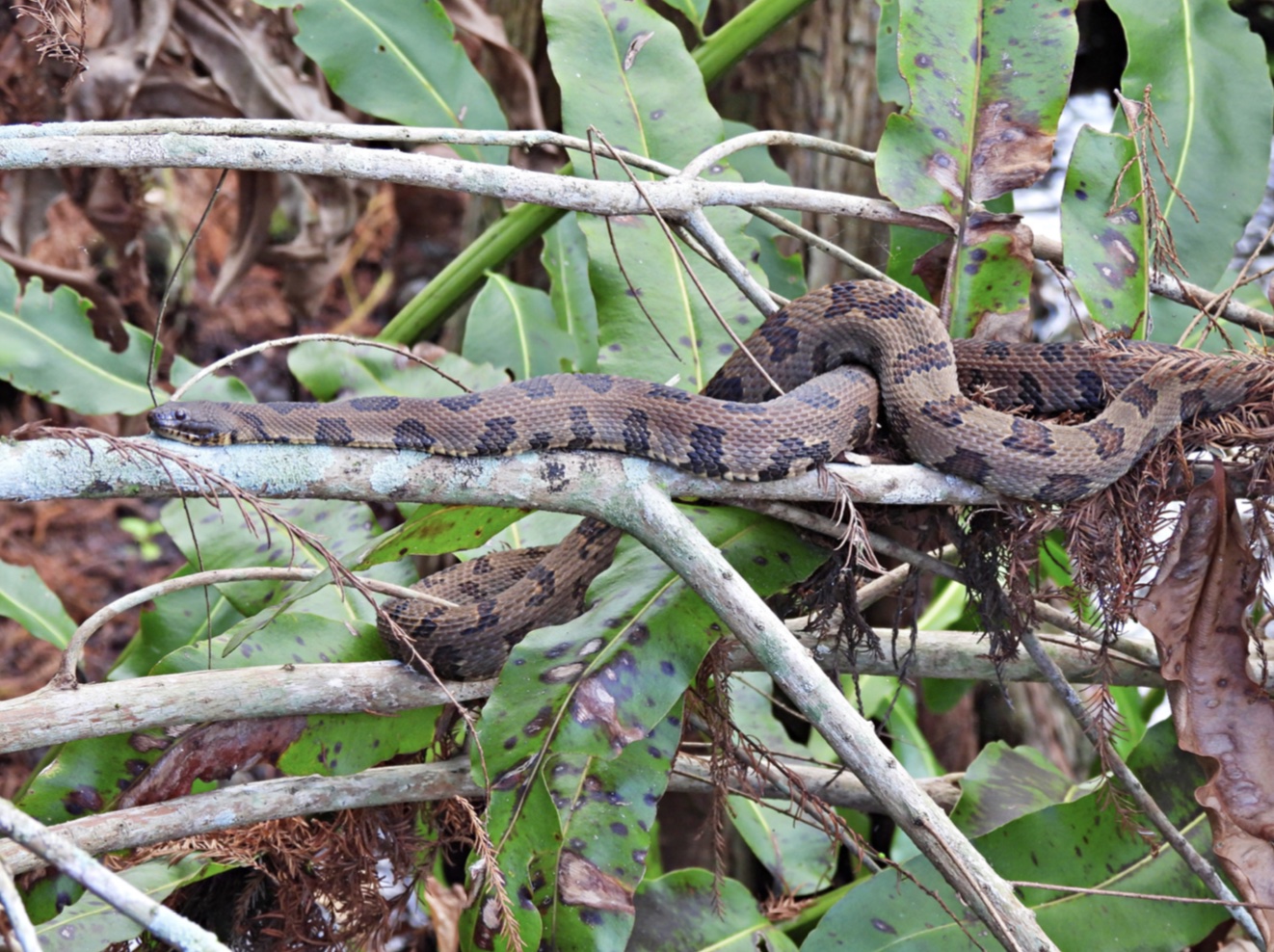
Brown Water Snake
Nerodia taxispilota
These water snakes can be found throughout the Coastal Plain and Piedmont regions of the Southeast, from southern Virginia to Florida. They can be found throughout Georgia, aside from the state’s northernmost region.
Brown Water Snakes are most commonly found in flowing waters, such as rivers and canals.
They will rarely stray from the water’s edge, because they don’t travel on land as much as other water snakes. But they can often be found hanging on vegetation or limbs up to 20 feet above the water!
Growing from around 2.5 to 5 feet long, Brown Water Snakes are light to dark brown, with a line of dark brown square blotches running down the center of their body and two other lines of blotches in alternating rows on their sides.
Like most water snakes, they have keeled scales and a triangular-shaped head, but it tends to be more narrow than other water snakes in the region. As you might imagine, their diet primarily consists of small fish.
READ MORE: The 10 Best Kayaking Rivers in Georgia

Banded Water Snake
Nerodia fasciata
The Banded Water Snake ranges from light brown to reddish to black in color.
They get their name from the dark bands that run along the length of their body, which are larger in the center of their back and become more narrow on the sides.
These semi-aquatic snakes are seen along the Coastal Plain of the U.S. in a variety of habitats, including streams, rivers, lakes, marshes, and canals, where they forage in shallow waters for amphibians and fish.
They are active both day and night, and are commonly sighted basking on logs or hanging on branches over the water.
READ MORE: The 10 Best Places for River Tubing in North Georgia
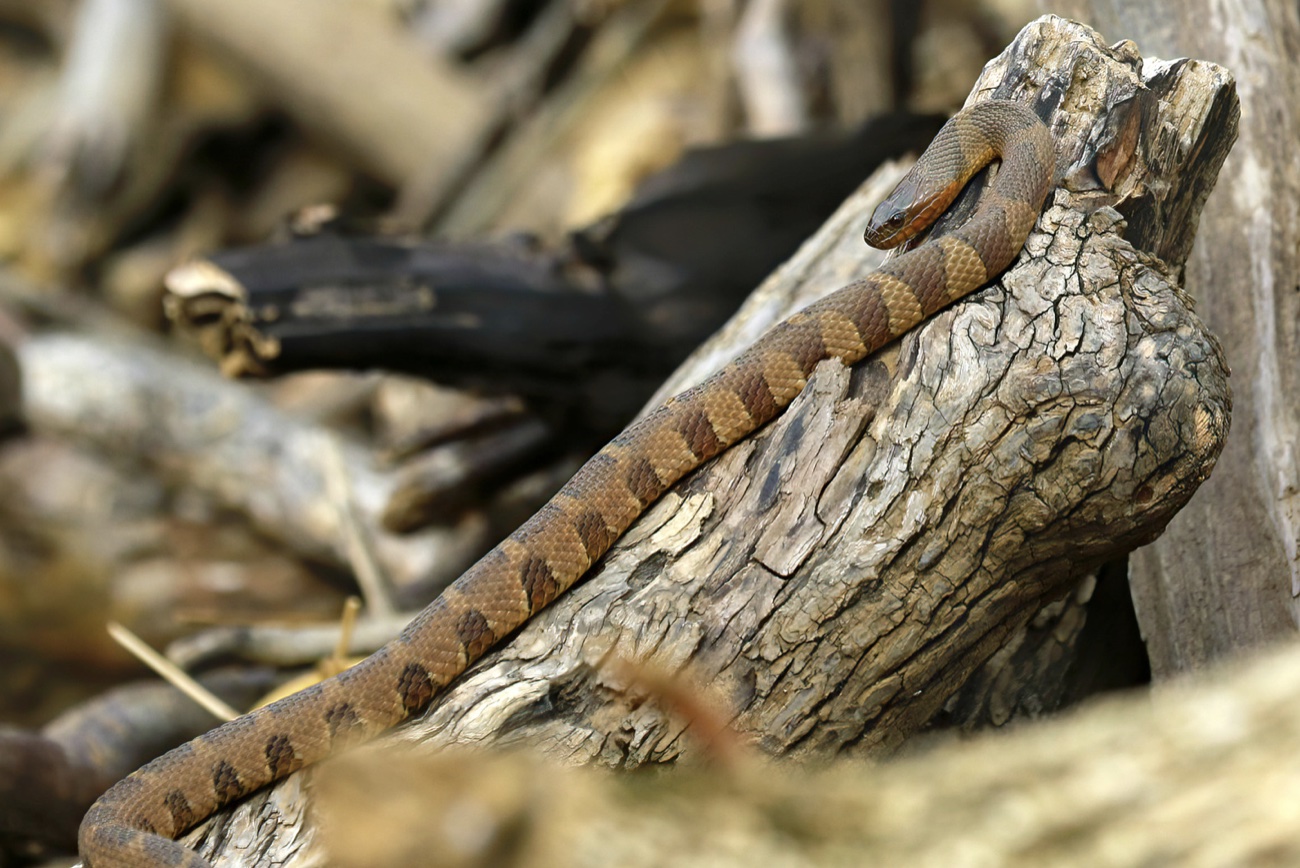
Northern Water Snake
Nerodia sipedon
Ranging from 2 to 4.5 feet long, Northern Water Snakes can be tan, grayish, or brown, with square blotches that run along their back. Like most water snakes, their scales are keeled and they feed on amphibians and fish.
They are often confused for the venomous Cottonmouth Snake, but can be distinguished by their distribution.
Cottonmouths are usually found in the Coastal Plain, whereas Northern Water Snakes are more often found in the Piedmont and Blue Ridge Mountains region.
These snakes are some of the most common water snakes in the U.S. and inhabit a wide variety of aquatic habitats, including lakes, marshes, rivers, ponds, and streams.
Chances are very good that, if you come across a water snake while hiking in Georgia, it’s probably this one!
READ MORE: How to Get to Anna Ruby Falls Near Helen, GA
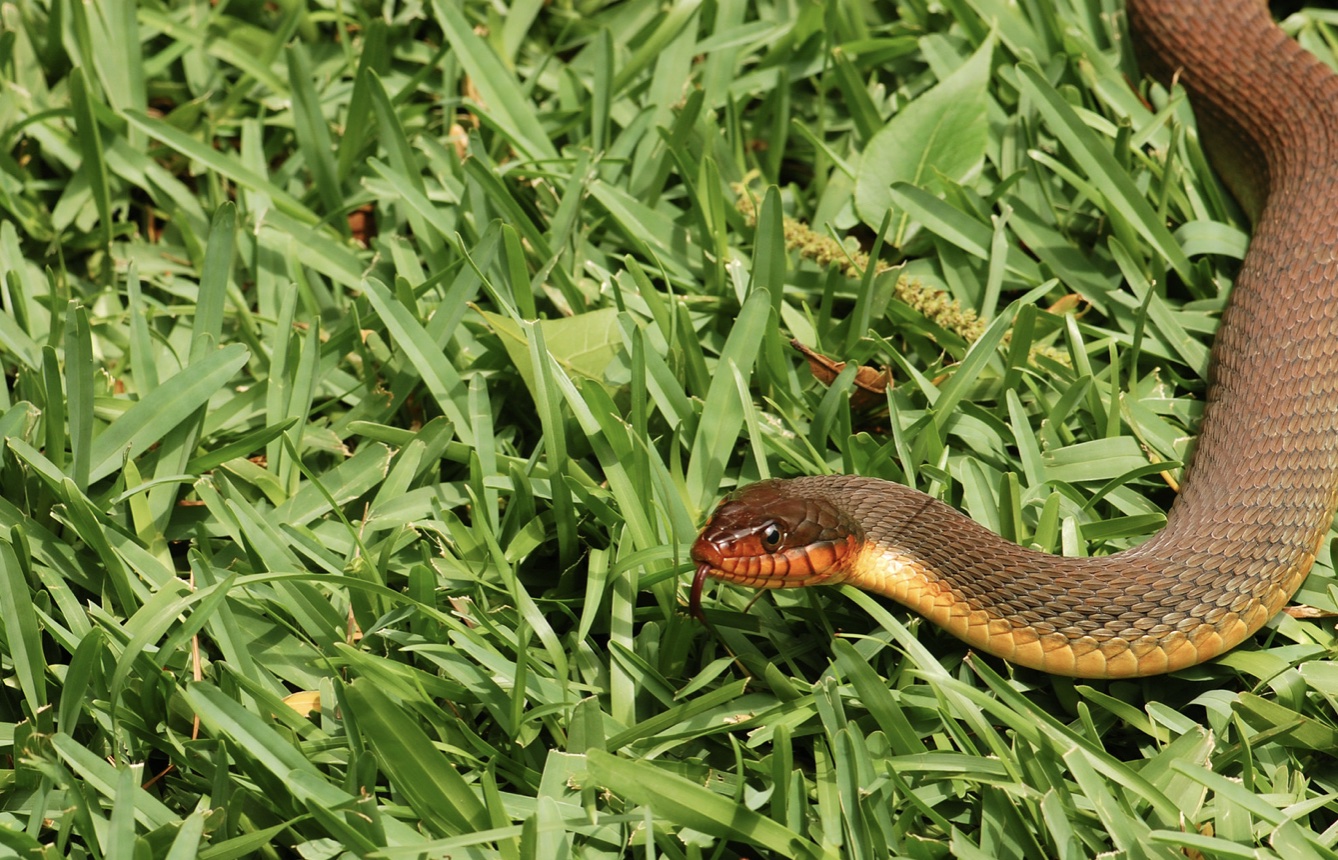
Red-bellied Water Snake
Nerodia erythrogaster
Easily identified by their bright reddish-orange belly, the Red-bellied Water Snake is grey or light to dark brown in color and can grow anywhere from 2.5 to 4 feet long.
These semi-aquatic snakescan be found throughout the Coastal Plain of the Southeast, as well as in some areas of the lower Piedmont.
They live throughout Georgia, except for the southeast corner and the northernmost mountainous region of the state.
During the day, you can spot them basking in the sun alongside wetlands, cypress swamps, and rivers. But at night they often travel on land and forage for their prey, which consists of amphibians and fish.
READ MORE: Vogel State Park: Camping, Hiking & History in North Georgia
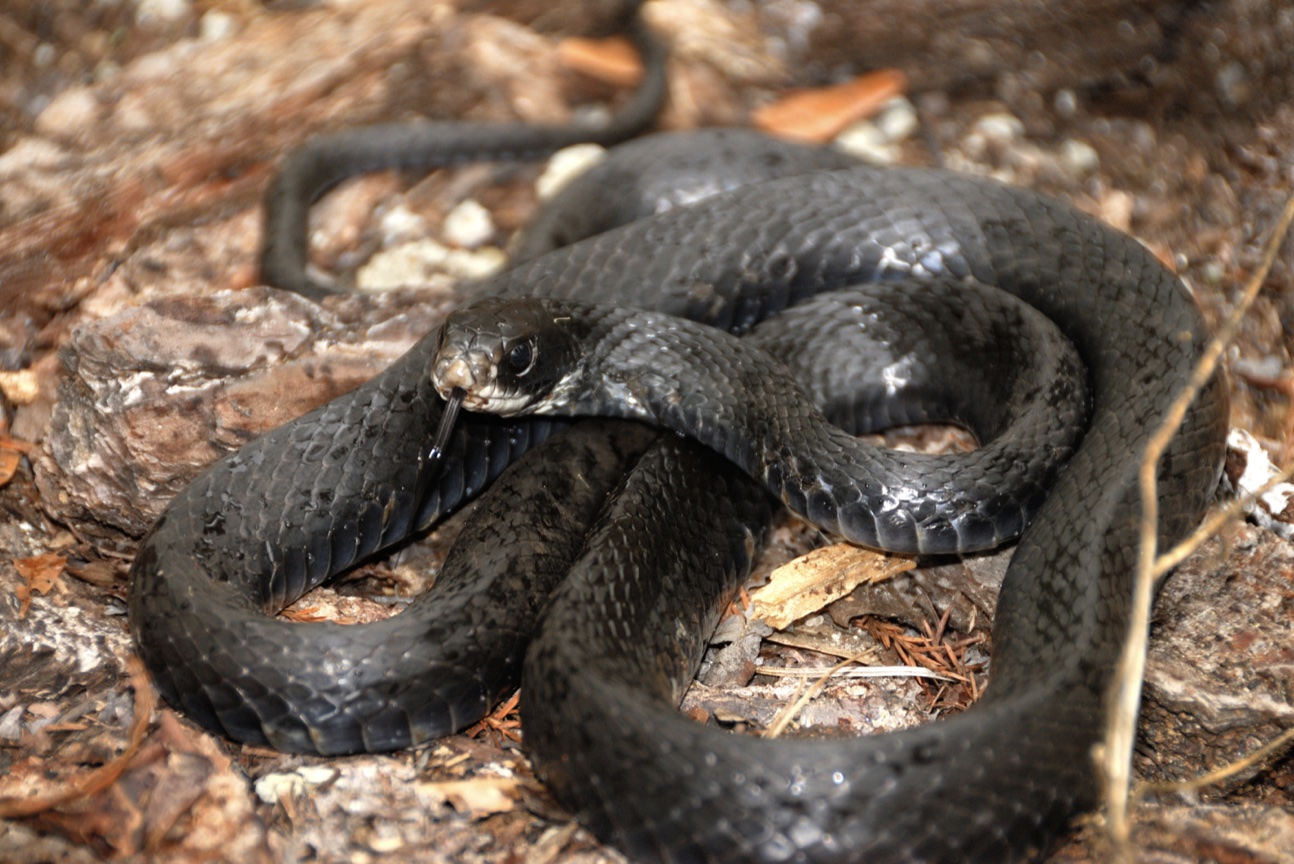
Black Racer
Coluber constrictor
Black Racers are slender, smooth-scaled black snakes that typically have white coloration under their chin.
They are easily confused with Black Rat Snakes, Eastern Hognose Snakes, or Black Kingsnakes. But they can be distinguished by their skinnier bodies and how they react when threatened.
Black Racers are faster than most other snakes, and will flee when in danger (whereas other snakes will freeze).
You can find Black Racers across the eastern U.S. and in all areas of Georgia. They occupy a variety of habitats, but are most commonly found in old fields, forests, and wetland edges.
Their diet consists of insects, lizards, birds, rodents, and amphibians. Although their scientific name suggests that they would constrict their prey, they actually chew and swallow it alive.
READ MORE: The 15 Best North Georgia State Parks & Historic Sites
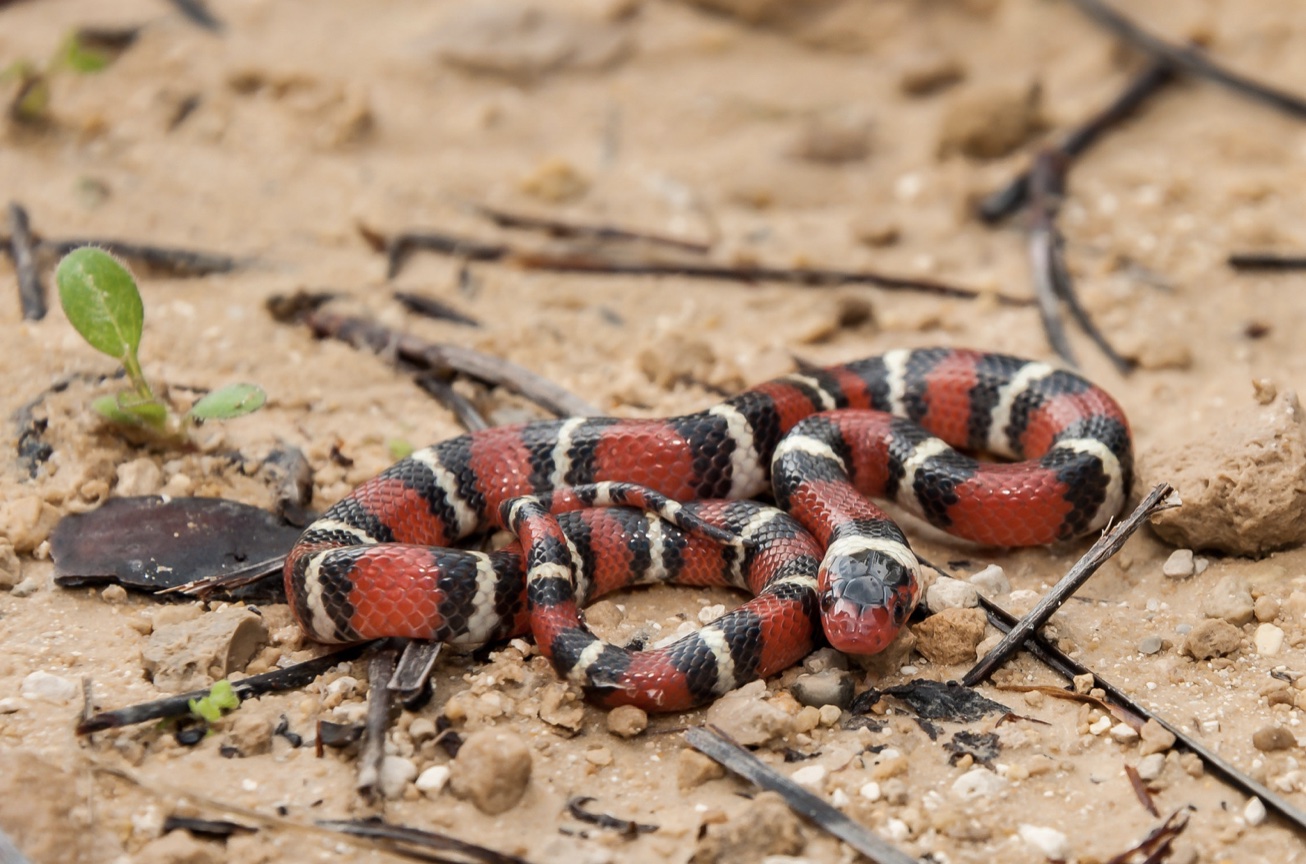
Scarlet Kingsnake
Lampropeltis elapsoides
Often confused for the venomous Eastern Coral Snake, the Scarlet Kingsnake is a beautifully colored snake with alternating red, black, and yellow bands. Unlike the Eastern Coral Snake, the red bands touch black, but not yellow.
These are small snakes with thin bodies that reach just over 1.5 feet long.
In Georgia, Scarlet Kingsnakes can be found all across the state, but are most commonly sighted in the Coastal Plain.
They can often be found in wet pinelands and hiding under rocks and logs, but you might even spot one in a tree or on a building since they are proficient climbers.
Like other Kingsnakes, they are a constrictor and prey on lizards, amphibians, and small mammals.
READ MORE: Barnsley Gardens Resort Ruins: The Tragic Story Behind the Adairsville, GA Landmark
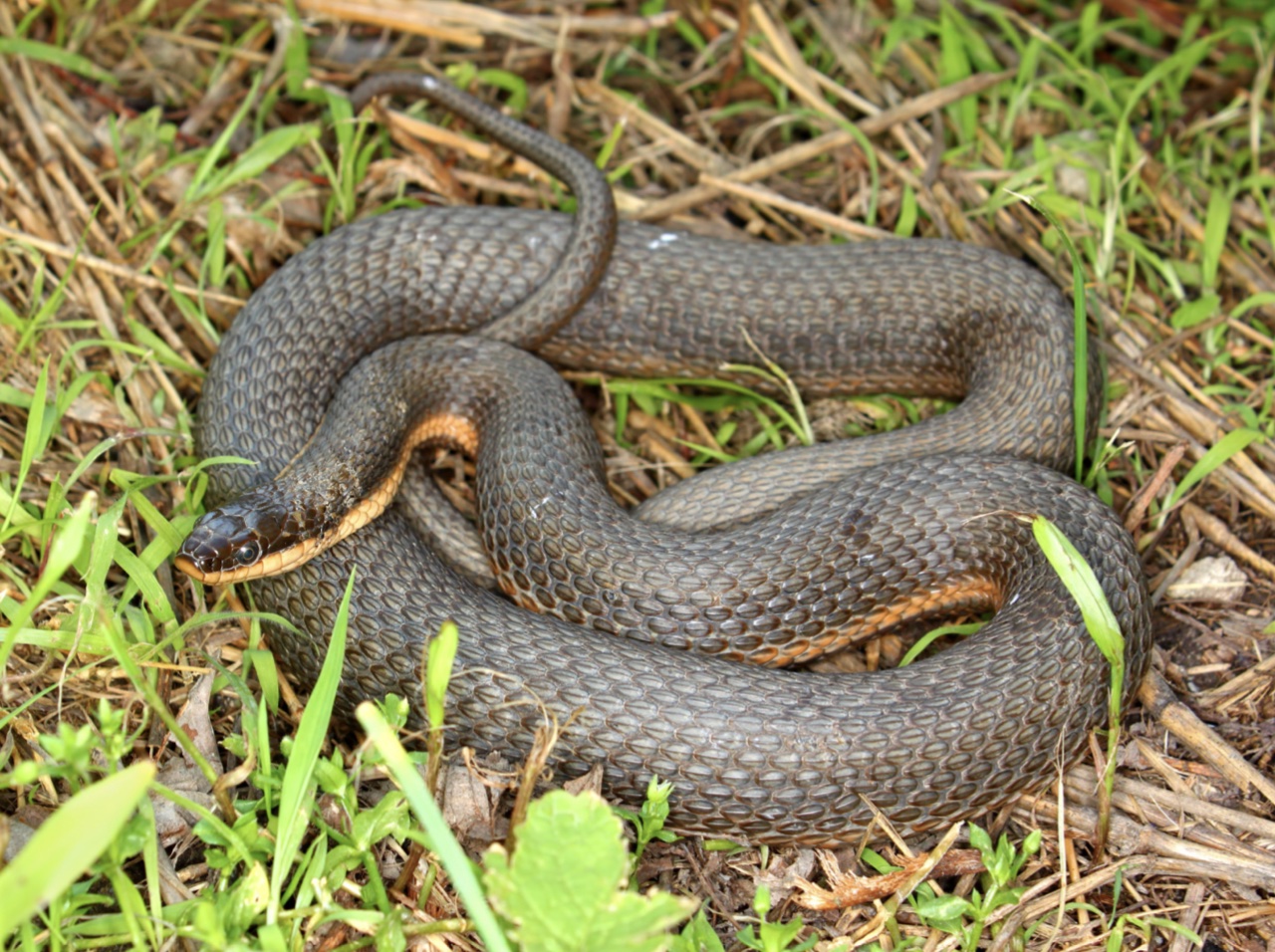
Queen Snake
Regina septemvittata
Queen Snakes are typically a greyish color, but can also be light brown or olive green. They are most identifiable by the two lighter stripes that run down the sides of their bodies.
Their range spans across the eastern U.S. In Georgia, Queen Snakes are most commonly found in the mountains and Piedmont region.
These are aquatic snakes that can often be found near running water, such as streams and rivers, where there is a high population of crayfish (their primary source of food).
They are most active during the day, but can also be spotted on land and crossing roads around dusk.
READ MORE: The 20 Best Places to Live in the Georgia Mountains

Worm Snake
Carphophis amoenus
One of the smallest snakes in Georgia at just over a foot long, Worm Snakes are brown snakes with shiny scales and a pinkish belly that extends partially onto their sides.
They can be found throughout the eastern U.S. from southern New England to central Georgia, where they typically live in deciduous woodlands. While common in north Georgia, they are rarely ever found in the Coastal Plain of the state.
Worm Snakes are seldom seen above ground, instead opting to spend most of their time under rocks, leaf litter, and in rotting logs.
They feed primarily on earthworms, but sometimes will supplement their diet with soft-bodied insect larvae and slugs.
READ MORE: Things to Do in Black Rock Mountain State Park Near Clayton GA
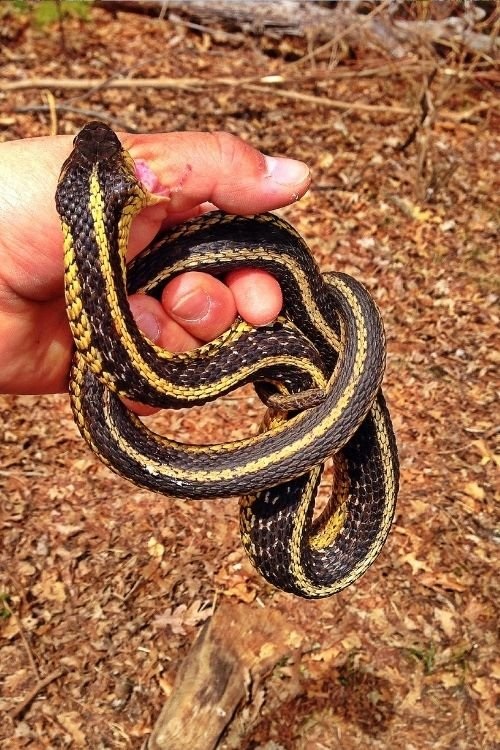
What to Do If You Get Bit By a Snake
In the rare case that you do get bit by a snake, you should always treat it as an emergency and call 911 immediately. Even if you think you can identify it as non-venomous, it’s always best to err on the side of caution.
One of the most important things you can do after getting a snakebite is to try your best to remain calm.
If you have been bitten by a venomous snake, remaining still can help slow down the spread of venom through your body. You should also remove any jewelry around the bite before any type of swelling begins.
While you’ve probably heard of some first aid tips– like applying tourniquets, sucking out the venom from a bite, or taking Benadryl– these are actually ineffective. In some cases, they can actually do more harm than good!
It’s really best to just leave the treatments to the professionals and focus on getting to them as fast as you can.
You should also avoid drinking alcohol or applying compressions or ice. And don’t put yourself or others at risk by trying to capture or kill the snake.
Just try to remember some identifying features so you can help the doctor identify the snake species.
READ MORE: A Guide to North GA Wildflowers (& Where to See Them)

What to Do If Your Dog Gets Snake Bit
If your dog happens to get bit by a snake in Georgia, it’s best to get them to the veterinarian as fast as possible. Most dogs will survive a snakebite if attended to immediately, so acting quickly is crucial.
Try to keep your pet as still as possible, and call the clinic before you arrive so they can prepare for treatment.
You won’t always see the bite happen. But unsteadiness in the hind legs, excessive salivation or drooling, dilated pupils, bloody urine, vomiting, or sudden weakness or collapse could indicate a snakebite and should be taken seriously.
Once again, don’t waste time trying to capture the snake. But if possible, remembering some key identifying features could be useful to the vet.
While a snake bite on you or your beloved furry friend can be scary, treatment is available and outcomes are usually good. The key here is just acting fast and getting to a medical professional asap. –by Christina Maggitas; lead image via Canva

